Dental Implants – San Jose, CA
Permanently Fill the Gaps in Your Smile
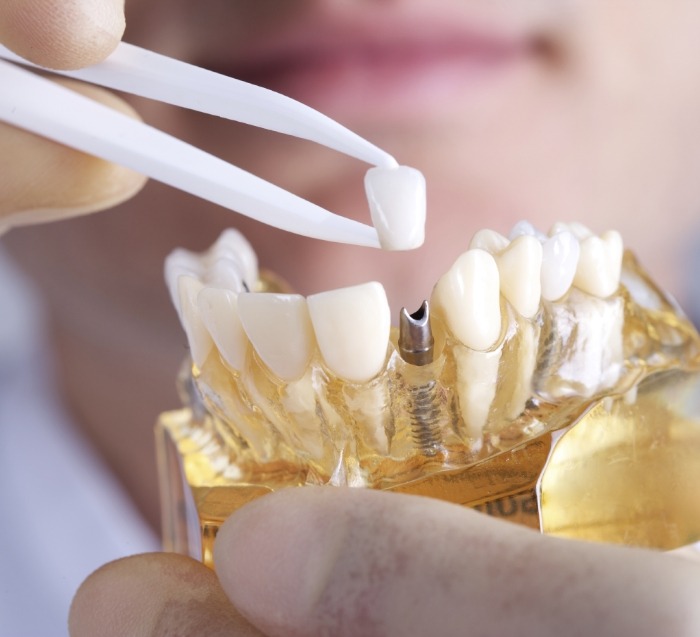
With Dr. Kelly Thanh, you can get the most advanced and longest-lasting tooth replacement right here in San Jose without having to visit multiple offices. She can place, restore, and maintain dental implants thanks to her experience and training, leading to a smoother and more cohesive patient experience that guarantees a positive and lasting result. If you’re ready to have your complete smile again, reach out today to get started.
Why Choose Dr. Kelly Thanh for Dental Implants?
- Dental Implants Placed & Restored In-House
- Same-Day Dental Implant Dentures
- Treatment Provided Using Latest Dental Technology
What are Dental Implants?
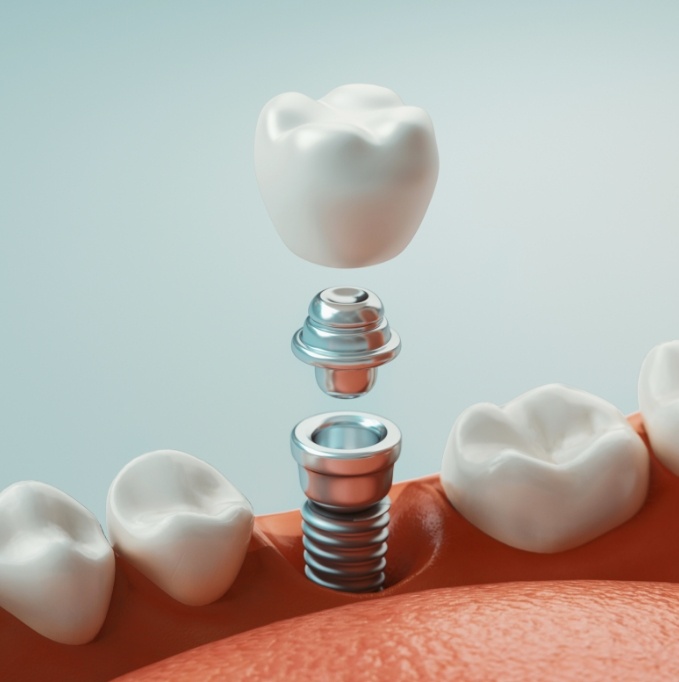
If you were to see someone smile who has dental implants, you wouldn’t be able to tell, and that’s part of the magic of the treatment! In truth, a patient’s new teeth are anchored to their jaw using small titanium posts that act like new tooth roots. They actually bond with the surrounding bone just like natural teeth, creating an extremely stable foundation for a crown, bridge, or denture.
The 4-Step Dental Implant Process

When you choose our practice for dental implants, you don’t need to worry about going to a specialist across town to have the implant posts placed. We’re able to complete the entire process in-office; you’ll have our friendly, knowledgeable team to help you every step of the way on the path to rebuilding your smile. To make sure that you’re truly ready for the dental implant process, here’s a closer look at the four main steps involved.
Initial Dental Implant Consultation
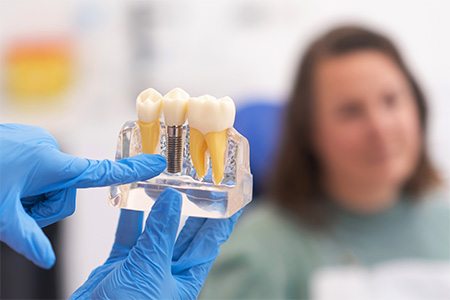
An initial consultation gives our team the opportunity to make sure dental implants are truly right for you. We will use the latest technology to evaluate the current state of your mouth and jaw in order to figure out whether you’re a candidate for dental implant surgery. Note that even if you aren’t currently able to have dental implants placed, you might be eligible for the procedure after bone grafting or other preliminary treatments.
If we find that dental implants are a good fit for you, we can go over your options and work with you to put together a treatment plan. We’ll let you know what you can expect in terms of cost and how long the process may take.
Dental Implant Surgery

Dental implant posts need to be surgically inserted into specific parts of your jaw. To do this, we will need to open your gum tissues so that we can work with the bone underneath. Each post will be placed at a carefully chosen angle. Then the gums will be sutured shut, and protective caps will be attached to each of the posts.
If you’re nervous about having dental implant surgery performed, rest assured that your comfort matters to us. Before the surgery begins, we will numb your mouth with a local anesthetic.
Dental Implant Osseointegration & Abutment
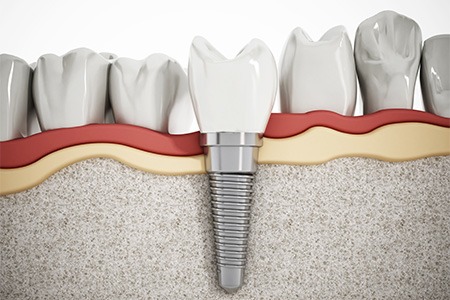
Thanks to osseointegration, your dental implants will gradually bond with the bone around them, essentially becoming part of your jaw. This process can take anywhere from three to six months depending on the patient. After successful osseointegration, you’ll be ready to receive your abutments. These are small pieces of metal that we can attach to your implant posts. Their purpose is to help keep your replacement teeth anchored in place.
Delivery of Dental Implant Restoration(s)
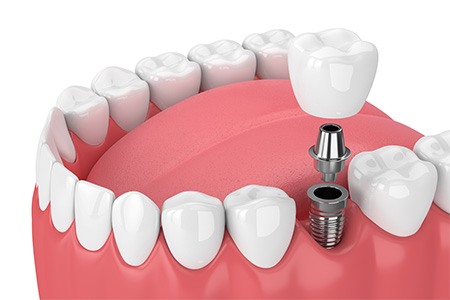
The right number of dental implants can support a crown, a bridge, or a denture. Whichever kind of prosthesis you need to complete your smile, it will be created at a trusted dental laboratory based on an accurate impression of your mouth. The completed prosthesis will be designed to look as lifelike as possible, allowing it to blend in seamlessly with your remaining teeth.
We’ll attach your new crown, bridge, or denture to your implant posts during one final appointment. Once they’re in place, we can give you tips for taking care of your newly re-completed grin.
Advanced Dental Implant Procedures

It may be necessary to take a few extra steps to ensure the success of your dental implants. For example, our team may use PRF therapy to help your mouth heal faster once the implant posts have been placed. We can also perform bone grafting to give your dental implants plenty of bone to form a lasting bond with. Before you begin the dental implant process, it’s worth taking the time to learn about some of the advanced procedures that could be part of it.
Bone Grafting
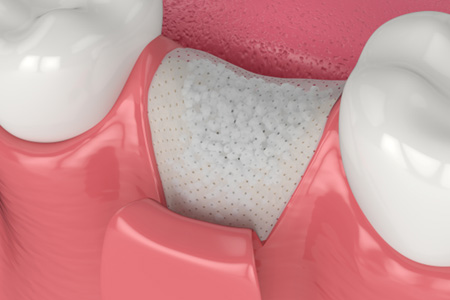
To be considered a candidate for dental implants, you need to have a sufficient amount of jawbone density. Dental implants are meant to fuse with the bone around them so that they can act as stable, sturdy artificial tooth roots. However, when teeth are missing, the lack of stimulation can cause the jaw to deteriorate. Consequently, there may not be enough bone available to successfully join with and support implant posts.
The good news is that even if your jaw has lost some of its bone density, you may qualify for dental implants after bone grafting. This procedure involves opening the gums and applying new bone tissue to the areas where deterioration has occurred. Said tissue may come from a different part of your body, but it could also be supplied by a donor. Once the grafting material is in place, it will gradually become integrated with the rest of the bone. After several months, your jaw will reach the point where it’s ready to receive dental implants.
PRF Treatment
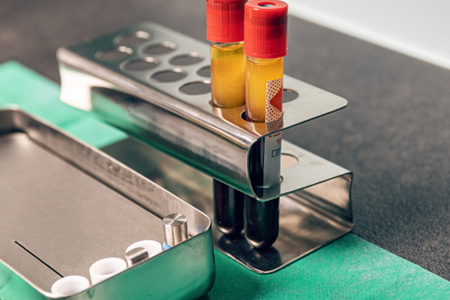
Once your dental implants have been placed, it will take time for your mouth to heal around them. Luckily, our team has a way to speed up the recovery process: PRF treatment. PRF stands for Platelet Rich Fibrin, and it involves taking advantage of the growth factors in your blood to stimulate healing.
To perform PRF treatment, a sample of your blood will need to be taken. Said sample will be placed in a centrifuge, which will help concentrate the platelets and growth factors present in the blood. The resulting substance is then applied to the area where the dental implants were inserted.
PRF is known to accelerate the healing process after dental implant placement. On top of that, it can reduce the discomfort and swelling that you experience following the procedure. And since PRF contains leukocytes (also known as white blood cells), it can significantly lower the risk of an infection occurring. In other words, by applying PRF to your mouth after dental implant surgery, our team can help ensure that your recovery goes as smoothly as possible.
Benefits of Dental Implants

Anchoring a titanium post to your jawbone might not sound like the best idea. However, this unique design allows dental implants to offer patients some unique benefits! Along with the usual advantages that come with replacing missing teeth in general (improved oral function, saving you money, etc.), you can expect your overall quality of life to improve drastically after treatment. To give you a more concrete idea of how dental implants can change your life for the better, read the information we’ve put together below.
Day-to-Day Benefits

How often do the gaps in your smile affect your usual routine? If you thought “on a daily basis!” you’ll be happy to know while dental implants are famous for their long-term health advantages, they’ll also improve your day-to-day experience. For example:
- Your implants will never slip or slide out of place. They’ll be firmly and securely fixed to your jawbone, just like natural teeth.
- You’ll have more room left for your tongue, meaning clearer speech. Dentures can be quite bulky, restricting your enunciation. Dental implants are small and sleek – once again like natural teeth.
- You’ll be able to eat whatever you want! Dental implants retain 80% - 90% of your bite force – which is a fancy way of saying they won’t affect your diet.
- They can be maintained with regular brushing, flossing, and dental checkups. Your dental implants will require no more care than the real thing.
Health Benefits
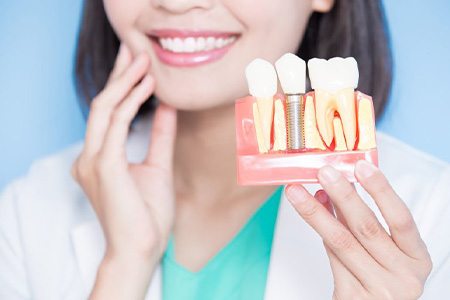
Teeth are kind of like nails; if they fall out, things start to come loose and fall apart. Here’s how dental implants help preserve your dental structure and oral health:
- The biocompatible titanium post replaces your lost dental roots, giving your jawbone something to cling to and preventing bone loss.
- They fill in your dental gaps, which stops any remaining teeth from shifting to compensate for the change.
- By increasing your bite power and chewing capacity, dental implants help your digestive system absorb essential nutrients more effectively.
Long-Term Benefits

Compared to other restoration options, dental implants last much longer on average. With proper care, they’ll go the distance for 30 years or more! You’ll be able to enjoy all the benefits mentioned above for several decades before it’s even time for a replacement.
If you’re mathematically inclined, you might have just realized another great aspect of getting dental implants: monetary savings. Since you likely won’t be needing repairs or replacements very often, dental implants start to pay for themselves over time. That’s more money you can put towards your personal goals – like retirement or a cruise-ship adventure!
Who Dental Implants Can Help

Many patients assume that dental implants are only feasible for those who have a lot of money and/or do not have additional oral or overall health problems. The truth is that these prosthetics can be a suitable option for most adults experiencing tooth loss. Whether immediate dental implant surgery is recommended or more advanced procedures are required first, a dental implant dentist in San Jose can make these artificial teeth a reality.
Who Is a Good Candidate for Dental Implants?
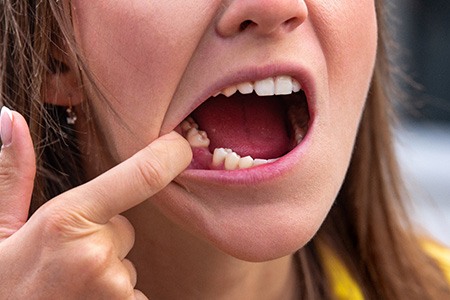
Determining your candidacy for dental implants requires an oral examination and discussion with Dr. Thanh and our team. This is the only way we can determine how soon you can receive these prosthetics. We’ll consider:
- Your oral health: We must identify whether any additional oral health issues exist (i.e., decay, cavities, gum disease) and prepare a plan to address them before you receive dental implants. If we see nothing concerning, you will likely be recommended to move on to the next step, which is dental implant surgery.
- Your overall health: We will discuss your medical history, current medications, and whether you are living with any conditions that could make healing from implant surgery more challenging. We’ll also evaluate whether your overall health might increase the risk of dental implant failure.
- The dentistry of your jawbone: A dense and supportive jawbone is necessary for implants to succeed long-term, so if we see that it has weakened over time, we may suggest a bone graft.
Missing One Tooth
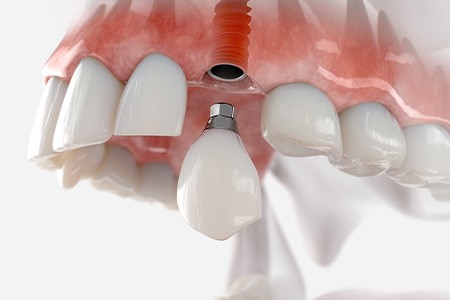
Even a single missing tooth can make certain daily tasks more difficult. However, with one titanium implant post and a custom dental crown, we can fill in the gap for good. Once it is fused with your jawbone, we’ll attach a metal abutment before securing the crown on top. This will complete the root-to-crown replacement and boost your oral function and aesthetics.
Missing Multiple Teeth
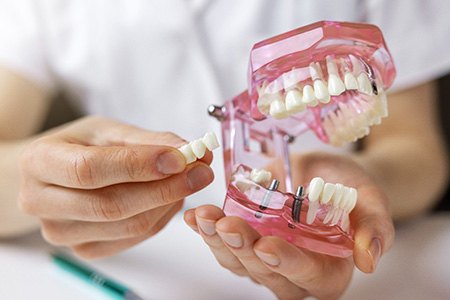
Altering healthy abutment teeth is not necessary when receiving an implant bridge. Instead, our team will insert two titanium posts into the sockets, allowing them to fuse through osseointegration. Once firmly in place, we’ll attach the appropriate abutments before making sure your new set of teeth is affixed on top. Not only will this provide greater stimulation to the bone, but you’ll no longer see a gap in your smile.
Missing All Teeth
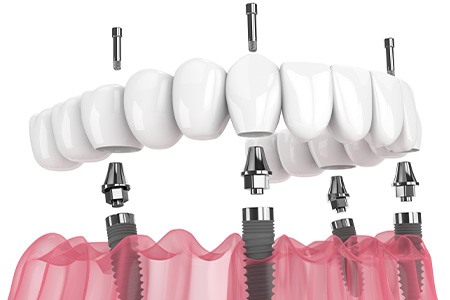
Facial changes, difficulty eating, slurred speech, and low self-esteem can be things of the past once we insert an implant denture. If you have an entire row of missing teeth, we can situate 4-6 implant posts along an arch before attaching a customized denture to complete your smile. The fabrication and placement of these teeth will allow for greater comfort, aesthetics, oral function, and confidence so that you can eagerly embrace life in the most fulfilling way.
Understanding the Cost of Dental Implants
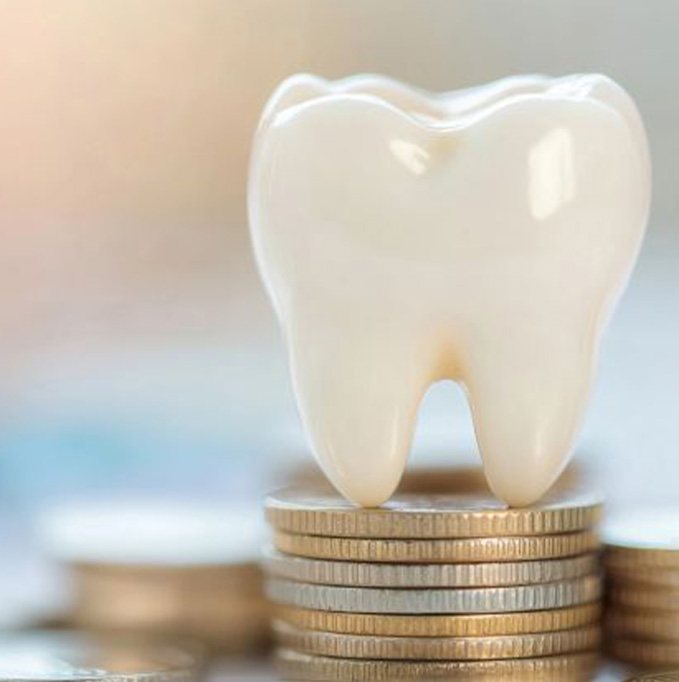
The cost of dental implants in San Jose depends on a few factors. During your consultation, we will consider the details of your unique case before providing a cost estimate. We will also talk to you about payment options, such as insurance and financing. You can rest assured that even though dental implants cost more upfront than alternative forms of tooth replacement, they are an excellent value and a great investment in your overall wellness!
Preliminary Treatments & Dental Implant Surgery
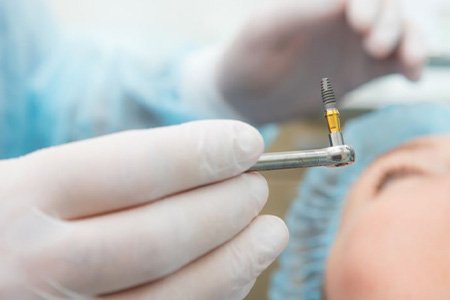
Some individuals require preparatory procedures, such as gum disease treatment, removal of teeth, or bone grafts, before dental implants may be placed. Each procedure carries its own separate fee.
Dental implant surgery has its own cost, which can depend on a few different factors, such as the number of implants placed. Since Dr. Thanh can perform this complex procedure in-house, you will not have to worry about visiting an outside specialist for the surgery. This can simplify the financial aspect of your care.
The Parts of Your Dental Implant
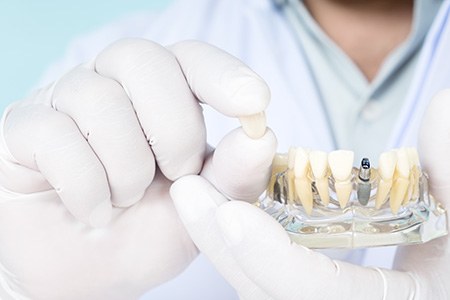
The details of dental implant treatment can vary greatly from case to case. Several factors may influence the overall cost of your care, including:
- The total number of implants required
- The size and style of the final restoration
- The manufacturer that produces your implants
- Fees charged by dental laboratories
- The materials used in your implants and restoration
Our team consistently selects high-quality materials for every stage of treatment. If you would like information about the origin of your implants, please ask for details.
How Dental Implants Can Save You Money

Dental implants typically involve a higher initial expense compared to other tooth replacement options. However, they often provide superior long-term value in at least two ways:
- Dental implants can last a very long time. Traditional dentures require replacement every 5 – 7 years or so, while dental implants may remain reliable and strong for several decades. When considering the daily cost of each treatment over time, implants may prove to be a more economical choice.
- Dental implants contribute positively to your overall health. They play a role in proper nutrition, help maintain the health of your jawbone, and offer additional benefits that might help decrease your overall medical costs throughout your lifetime.
Does My Dental Insurance Cover Dental Implants?
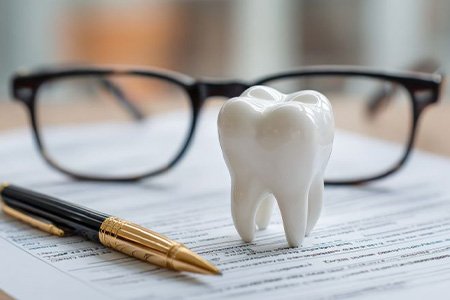
Coverage for dental implants is unpredictable. Some plans cover them, while others do not. Our San Jose team welcomes insurance, and we are even in-network with a few popular plans. We can help you figure out how your benefits may apply.
Even if your dental insurance does not cover the implants themselves, it will likely cover other aspects of your care. For example, it may help with preliminary treatments or the cost of your final crown, bridge, or denture.
Making Dental Implants Affordable

Outside of insurance, another provision that might make it easier for you to afford dental implants is financing through CareCredit. CareCredit is a third-party lending company that provides low-interest and no-interest payment plans for medical and dental services. The application process is fast, and most people are quickly approved for a monthly installment arrangement that works within their budget.
Are you interested in learning more about dental implants and their cost? Contact our office today to ask questions or request a consultation. We look forward to serving you!
